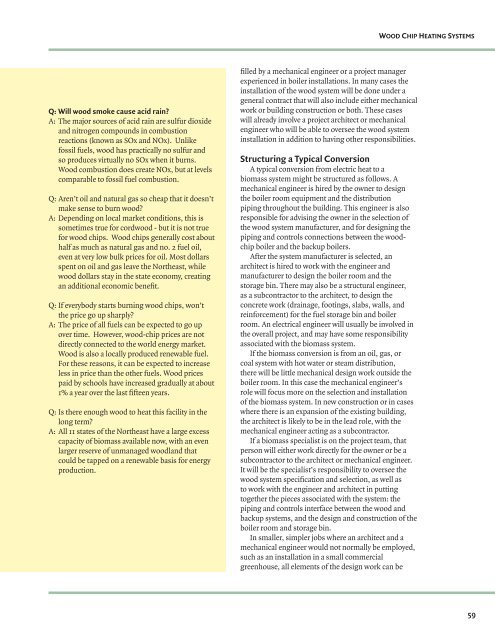Wood-Chip Heating Systems - Biomass Energy Resource Center
Wood-Chip Heating Systems - Biomass Energy Resource Center
Wood-Chip Heating Systems - Biomass Energy Resource Center
Create successful ePaper yourself
Turn your PDF publications into a flip-book with our unique Google optimized e-Paper software.
Q: Will wood smoke cause acid rain?<br />
A: The major sources of acid rain are sulfur dioxide<br />
and nitrogen compounds in combustion<br />
reactions (known as SOx and NOx). Unlike<br />
fossil fuels, wood has practically no sulfur and<br />
so produces virtually no SOx when it burns.<br />
<strong>Wood</strong> combustion does create NOx, but at levels<br />
comparable to fossil fuel combustion.<br />
Q: Aren’t oil and natural gas so cheap that it doesn’t<br />
make sense to burn wood?<br />
A: Depending on local market conditions, this is<br />
sometimes true for cordwood - but it is not true<br />
for wood chips. <strong>Wood</strong> chips generally cost about<br />
half as much as natural gas and no. 2 fuel oil,<br />
even at very low bulk prices for oil. Most dollars<br />
spent on oil and gas leave the Northeast, while<br />
wood dollars stay in the state economy, creating<br />
an additional economic benefi t.<br />
Q: If everybody starts burning wood chips, won’t<br />
the price go up sharply?<br />
A: The price of all fuels can be expected to go up<br />
over time. However, wood-chip prices are not<br />
directly connected to the world energy market.<br />
<strong>Wood</strong> is also a locally produced renewable fuel.<br />
For these reasons, it can be expected to increase<br />
less in price than the other fuels. <strong>Wood</strong> prices<br />
paid by schools have increased gradually at about<br />
1% a year over the last fi fteen years.<br />
Q: Is there enough wood to heat this facility in the<br />
long term?<br />
A: All 11 states of the Northeast have a large excess<br />
capacity of biomass available now, with an even<br />
larger reserve of unmanaged woodland that<br />
could be tapped on a renewable basis for energy<br />
production.<br />
fi lled by a mechanical engineer or a project manager<br />
experienced in boiler installations. In many cases the<br />
installation of the wood system will be done under a<br />
general contract that will also include either mechanical<br />
work or building construction or both. These cases<br />
will already involve a project architect or mechanical<br />
engineer who will be able to oversee the wood system<br />
installation in addition to having other responsibilities.<br />
Structuring a Typical Conversion<br />
A typical conversion from electric heat to a<br />
biomass system might be structured as follows. A<br />
mechanical engineer is hired by the owner to design<br />
the boiler room equipment and the distribution<br />
piping throughout the building. This engineer is also<br />
responsible for advising the owner in the selection of<br />
the wood system manufacturer, and for designing the<br />
piping and controls connections between the woodchip<br />
boiler and the backup boilers.<br />
After the system manufacturer is selected, an<br />
architect is hired to work with the engineer and<br />
manufacturer to design the boiler room and the<br />
storage bin. There may also be a structural engineer,<br />
as a subcontractor to the architect, to design the<br />
concrete work (drainage, footings, slabs, walls, and<br />
reinforcement) for the fuel storage bin and boiler<br />
room. An electrical engineer will usually be involved in<br />
the overall project, and may have some responsibility<br />
associated with the biomass system.<br />
If the biomass conversion is from an oil, gas, or<br />
coal system with hot water or steam distribution,<br />
there will be little mechanical design work outside the<br />
boiler room. In this case the mechanical engineer’s<br />
role will focus more on the selection and installation<br />
of the biomass system. In new construction or in cases<br />
where there is an expansion of the existing building,<br />
the architect is likely to be in the lead role, with the<br />
mechanical engineer acting as a subcontractor.<br />
If a biomass specialist is on the project team, that<br />
person will either work directly for the owner or be a<br />
subcontractor to the architect or mechanical engineer.<br />
It will be the specialist’s responsibility to oversee the<br />
wood system specifi cation and selection, as well as<br />
to work with the engineer and architect in putting<br />
together the pieces associated with the system: the<br />
piping and controls interface between the wood and<br />
backup systems, and the design and construction of the<br />
boiler room and storage bin.<br />
In smaller, simpler jobs where an architect and a<br />
mechanical engineer would not normally be employed,<br />
such as an installation in a small commercial<br />
greenhouse, all elements of the design work can be<br />
WOOD CHIP HEATING SYSTEMS<br />
59





